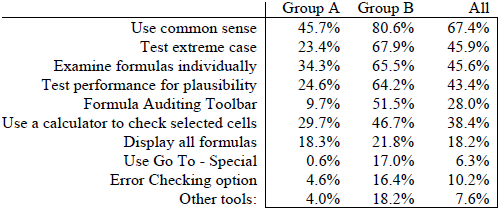Authors
Kenneth R. Baker, Stephen G. Powell, Barry Lawson, & Lynn Foster-Johnson
Abstract
We developed an internet-based questionnaire on spreadsheet use that we administered to a large number of users in several companies and organizations to document how spreadsheets are currently being developed and used in business.
In this paper, we discuss the results drawn from of a comparison of responses from individuals with the most experience and expertise with those from individuals with the least.
These results describe two views of spreadsheet design and use in organizations, and reflect gaps between these two groups and between these groups and the entire population of nearly 1600 respondents.
Moreover, our results indicate that these gaps have multiple dimensions: they reflect not only the context, skill, and practices of individual users but also the policies of large organizations.
Sample

We surveyed two distinct subgroups:
- Group A. Those who classify themselves as normally working on non-critical and small spreadsheets and with limited expertise.
- Group B. Those who classify themselves as working on spreadsheets that are 'critical' for their organization and as possessing high expertise and normally working on very large spreadsheets.
This table shows that repondents use a range of techniques to evaluate their spreadsheets.
Group B takes more advantage of all these techniques than those in Group A.
The average Group B respondent also uses four of these approaches while the average Group A respondent uses only two.
Publication
2008, EuSpRIG
Full article
Also see
A comparison of spreadsheet users with different levels of experience
